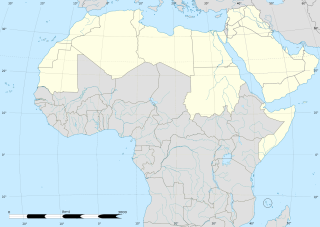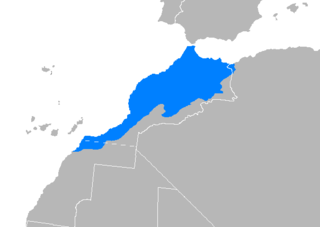Related Research Articles

This article is about the demographic features of the population of Morocco, including population density, ethnicity, education level, health of the populace, economic status, religious affiliations and other aspects of the population.

The Arab world, formally the Arab homeland, also known as the Arab nation, the Arabsphere, or the Arab states, consists of the 22 Arab countries which are members of the Arab League. A majority of these countries are located in Western Asia, Northern Africa, Western Africa, and Eastern Africa. The region stretches from the Atlantic Ocean in the west to the Arabian Sea in the east, and from the Mediterranean Sea in the north to the Indian Ocean in the southeast. The eastern part of the Arab world is known as the Mashriq, and the western part as the Maghreb. Arabic is used as the lingua franca throughout the Arab world.

Maghrebi Arabic is a vernacular Arabic dialect continuum spoken in the Maghreb region, in Morocco, Algeria, Tunisia, Libya, Western Sahara, and Mauritania. It includes Moroccan, Algerian, Tunisian, Libyan, and Hassaniya Arabic. It is known locally as Darja, Derdja, Derja, Derija or Darija, depending on the region's dialect.. This serves to differentiate the spoken vernacular from Standard Arabic. The Maltese language is believed to be derived from Siculo-Arabic and ultimately from Tunisian Arabic, as it contains some typical Maghrebi Arabic areal characteristics.

Arabization or Arabisation describes both the process of growing Arab influence on non-Arab populations, causing a language shift by the latter's gradual adoption of the Arabic language and incorporation of Arab culture, as well as the Arab nationalist policies of some governments in modern Arab states toward non-Arab minorities, including Lebanon, Kuwait, Iraq, Syria, Palestine, Sudan, Mauritania, Algeria, Libya, and the Islamic State of Iraq and the Levant.

Samira Abdul Razzaq Bensaïd, professionally known as Samira Said, is a Moroccan-Egyptian singer.
The culture of Morocco represents and is shaped by a confluence of influences throughout history. This sphere may include, among others, the fields of personal or collective behaviors, language, customs, knowledge, beliefs, arts, legislation, gastronomy, music, poetry, architecture, etc. ... While Morocco started to be stably predominantly Sunni Muslim starting from 9th-10th century AD, in the Almoravids empire period, a very significant old Jewish population had contributed to the shaping of Moroccan culture. In antiquity, starting from the second century A.D and up to the seventh, a rural Donatist Christianity was present, along an urban still-in-the-making Roman Catholicism. All of the cultural super strata tend to rely on a multi millennial aboriginal Amazigh substratum still strongly present and dates back to prehistoric times.
The Arabic chat alphabet, Arabizi, Franco-Arabic, Arabish, Araby, and Mu'arrab (معرب), refer to the Romanized alphabets for informal Arabic dialects in which Arabic script is transcribed or encoded into a combination of Latin script and Arabic numerals. These informal chat alphabets were originally used primarily by youth in the Arab world in very informal settings—especially for communicating over the Internet or for sending messages via cellular phones—though use is not necessarily restricted by age anymore and these chat alphabets have been used in other media such as advertising.
Mohamed Choukri, born on July 15, 1935 and died on November 15, 2003, was a Moroccan author and novelist who is best known for his internationally acclaimed autobiography For Bread Alone, which was described by the American playwright Tennessee Williams as "A true document of human desperation, shattering in its impact".
Moroccan literature is the literature produced by people who lived in or were culturally connected to Morocco and the historical states that have existed partially or entirely within the geographical area that is now Morocco. Apart from the various forms of oral literature, the written literature of Morocco encompasses various genres, including poetry, prose, theater, and nonfiction like religious literature, and was written in the different languages spoken in Morocco throughout history: Amazigh languages, Darija, Arabic, Hebrew, Latin, French, Spanish, or English. Through translations into English and other languages, Moroccan literature originally written in Arabic or one of the other native languages has become accessible to readers worldwide.

Mohammed Bennis is a Moroccan poet and one of the most prominent writers of modern Arabic poetry. Since the 1970s, he has enjoyed a particular status within Arab culture. Muhsin J al-Musawi states that "Bennis’ articulations tend to validate his poetry in the first place, to encapsulate the overlapping and contestation of genres in a dialectic, that takes into account power politics whose tropes are special. As a discursive threshold between Arab East and the Moroccan West, tradition and modernity, and also a site of contestation and configuration, Muhammad Bennis' self-justifications may reveal another poetic predilection, too."
Moroccan rap music is a Moroccan musical style related to rap and hip hop culture.

There are a number of languages of Morocco. The two official languages are Standard Arabic and Tamazight. Moroccan Arabic is the spoken native vernacular. The languages of prestige in Morocco are Arabic in its Classical and Modern Standard Forms and sometimes French, the latter of which serves as a second language for approximately 33% of Moroccans. According to a 2000–2002 survey done by Moha Ennaji, author of Multilingualism, Cultural Identity, and Education in Morocco, "there is a general agreement that Standard Arabic, Moroccan Arabic, and Berber are the national languages." Ennaji also concluded "This survey confirms the idea that multilingualism in Morocco is a vivid sociolinguistic phenomenon, which is favored by many people."
The KtbDarija(Literally "WriteDarija") is a project aiming at standardizing the writing of Darija, to improve literacy rate and make it easier to learn for foreigners. It is double standard that support both Latin and Abjad alphabets. A set of keyboard layouts for writing in these alphabets have also been developed.

Moroccan Arabic, known as Darija in Morocco, is a form of vernacular Arabic spoken in Morocco. It is part of the Maghrebi Arabic dialect continuum and as such is mutually intelligible to some extent with Algerian Arabic and to a lesser extent with Tunisian Arabic. It is spoken as a first language by about 50% to 75% of Morocco's population. Most other Moroccans natively speak one of the Tamazight languages. Educated Moroccan Tamazight speakers can communicate in mainstream Moroccan Arabic.
Arab-Berbers are an ethnolinguistic group of the Maghreb, a vast region of North Africa in the western part of the Arab world along the Mediterranean Sea and the Atlantic Ocean. Arab-Berbers are people of mixed Arab and Berber origin, most of whom speak a variant of Maghrebi Arabic as their native language, although about 16 to 25 million speak various Berber languages. Many Arab-Berbers identify primarily as Arab and secondarily as Berber.

Oum El Ghaït Benessahraoui, better known as Oum, is a Moroccan singer-songwriter. Considered an ambassador of Moroccan culture, she mixes hassani, jazz, gospel, soul, afrobeat and Sufi music influences in her songs.
Mustapha El Fekkak, also known as Mustapha Swinga, is a Moroccan YouTuber and businessman, mostly known for his program "Aji Tfham" in Moroccan Darija. In 2014, he won the prize of "Person of the Year" in the 7th edition of Maroc Web Awards, Creativity category.
Hicham Nostik born in 1976 in Taza, Morocco, is a Moroccan writer, YouTuber and podcaster, living in Canada, most known for his outspoken stance against Islam and religion in general, expressed through his books, podcasts and comedy videos, in Moroccan Darija and Standard Arabic.
Notes of a Moroccan Infidel is an autobiographical book of Moroccan atheist author Hicham Nostik, where he recounts his childhood in Morocco and life in Germany until he left Islam. It was a best-selling book in the 2019 and 2020 editions of the Casablanca Book Fair. All copies of the first edition (2019) were sold out within a few days.

Dourouf El Guaddar known professionally as Nores, is a Moroccan rapper and music producer.
References
- ↑ "Stephanie Enemark, Some Key Figures". Archived from the original on 2008-03-31. Retrieved 2008-05-26.
- ↑ "أحمد لمسيح للميادين نت: كثير من الزجّالين المغاربة سجناء وهْم التراث" (in Arabic).